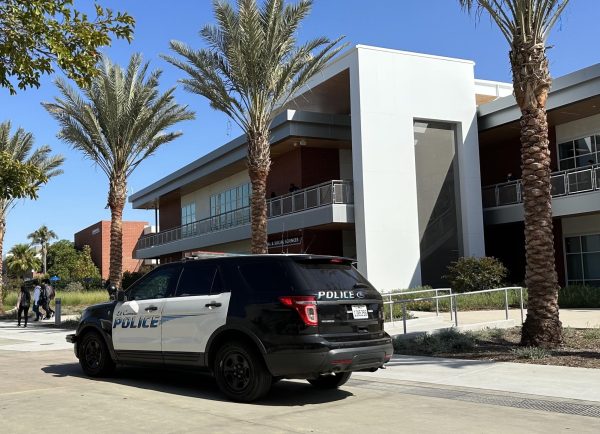Local prize needs community help
In a field of flowers, scattered crows, hummingbirds and bushtits flit from tree to tree. At night, raccoons haunt the premises, leaving behind prints the size of a ballpoint pen. Above it all, dense scores of Goddings willows blanket the sky.
All 13 acres of it is just three miles from campus, in Gardena.
Hard to believe? That’s because the Willow Wetlands Preserve is hidden behind the bustle of a shopping center and a long stretch of highway leading to the 91 and the 110 freeways.
“Most people here don’t know an area like this exists,” Gardena Parks superintendent Dave Negrete said.
Due to its obscurity, the Wetlands needs a little assistance, both financially and physically.
It is not open formally and tours are scheduled by phone, headed by Negrete. The area has never been allocated manpower to maintain the willows.
For four hours on some Saturdays, Negrete and a number of volunteers unlock the gates and clear the preserve of non-native plants (otherwise known as weeds) and debris that wash up from storm drains.
“This here is urban gold,” Mark Lawrence, 43, firefighter and also a volunteer at the Madrona Marsh in Torrance, said. “How many more places like this are around here? That’s why I’m here protecting what we have left.”
The wetlands serves as a drainage system for parts of Gardena, including Vermont and Western avenues and Artesia and Redondo Beach boulervards, before it ends up in the Dominguez Channel and eventually in the Pacific Ocean.
Because of the filtering process, the streams and drifts are filled with styrofoam cups, empty water bottles, potato chip bags, candy wrappers and even stray tennis balls.
“This is what we’re trying to educate kids on. We emphasize that we’ve got a natural area that needs to be protected by not dumping things in the storm drains and the gutters,” Negrete said. “The trash doesn’t go away. It ends up in places like this.”
“At some point, we want to be open to the public, but it’s gonna come from a community effort,” Negrete added.
The wetlands has already attracted interest from specialized groups.
The National Wildlife Federation hosts a program called FrogwatchUSA, whose members visit the site periodically to monitor and study the frog population.
The National Audubon Society comes for the birds. Every Christmas for more than 16 years, its members have conducted a Christmas bird count to enjoy Gardena’s population of feathered friends.
Both EC and Cal State Dominguez Hills have been components in taking action as well.
Jeanne Bellemin, EC zoology professor, taught a class on environmental restoration last fall that brought the Wetlands and natural preserves to students’ attention
“The reserve is really nice in that it shows you what it used to be like around here,” Bellemin said.
Bellemin is also involved in maintaining her own piece of nature in Alondra Park Island in Torrance, where she stresses planting native vegetation. As of 2003, the island boasted more than 86 varieties of plants and flowers.
“We’re trying to get the original gene pool represented,” she said.
At the wetlands, which is made up of 95 percent of native plant material, that’s not a problem.
Besides the giant willows that dominate the scene, thin, bamboo-like plant stalks tower above the native daisies, lupines and elderberries in abundance.
“The willows are really vibrant and healthy,” Negrete said.
The other 5 percent of the preserve is non-native plants territory.
Home to more than 140 species of birds, including migratory birds, the wetlands is subject to seeds from other regions dropping and germinating on willow soil.
A gnarled peach tree which Negrete refers to as “the mother of all peach trees” spawns the other peach trees scattered throughout the area.
Primrose vines float atop the ponds and stream banks.
In certain nooks, the licorice smell of fennel wafts through the air.
Negrete has big plans for the future; docents conducting tours and educational programs, completing trails and building a nature center atop a grassy knoll in the preserve are just a few of the ideas.
“I always envisioned a two-story affair with a treehouse where people can get out their binoculars and just enjoy the peace and quiet that’s here,” Negrete said.
Big dreams come with a price. At the wetlands, that price is expensive and currently unattainable.
“Imagine you’re a homeowner and you don’t have money. What do you cut out? You cut out vacations, you cut out luxuries, you cut out entertainment. This is where we’re at, and we’re not even providing the bare essentials here with the money that we have,” Negrete said.
Gone are the days when neighborhood residents would play and explore the marsh before it was declared a navigable water site by the Army Corps and was locked up in the late ’70s.
Ghostly remains of a tree house are still perched in the branches of one of the willows.
The preserve remained a locked facility until the early ’90s, when Negrete and his team applied for a grant and received more than $1.2 million in funds for restoration and rehabilitation of the area.
However, for the present, the preserve has managed, in spite of being largely unknown.
“We’re very proud of it,” Negrete said. “We just want to highlight this rare little jewel that we have in the city.”
Students interested in more information on the wetlands may contact Negrete at 310-217-9562.









